
Holland Hall – dubbed “Hogwarts” by many on the St. Olaf campus – reopened in late August, almost three months after the projected completion date of May 31, 2017. Academic departments have moved back into the new office spaces, now located around the building’s perimeter, and classes are being held while landscaping work on the east end is being finished.
The new space boasts open staircases, gingham wingback furniture and vaulted ceilings with exposed iron beams. Holland had previously lacked student study spaces, but the new design incorporates multiple lounges and waiting areas for professor office hours. The sixth floor previously housed small offices, but is now a large, open loft space, rivaling the fourth floor of Regents Hall of Natural Sciences.
This loft space is called the Carol and Ward Klein Learning Loft, after the donors who gifted $1 million to the project during St. Olaf’s For the Hill and Beyond fundraising campaign.
One of the primary goals of the year and a half long renovation was to “maximize natural daylight and views throughout floor,” according to the original design team presentation. The previous design inefficiently carried light through the building, leaving the exterior classrooms bright and the interior space dimly lit. The new interior resembles Regents in that it carries light effectively from one end of the building through to the other. The white walls provide a reflective surface which brightens the entire building.
St. Olaf partnered with the Minneapolis-based architectural firm Perkins+Will to complete the project, estimated to cost about $13 million. The firm has taken on a number of notable projects in the Minneapolis area, including the renovation of the Capella tower lobby in downtown Minneapolis and has also completed higher education projects at the University of North Dakota.
Originally built in 1992 to house the administration and sciences, Holland was renovated in 1968 to include the academic departments it currently holds – political science, history, sociology/anthropology, economics and philosophy. According to the St. Olaf website, academic buildings are on a forty year rotation for renovations (for reference, residence halls are renovated every nine years). Holland missed its turn after the College’s Strategic Plan placed an emphasis on revamping residence halls, but the project was made possible after the College refinanced its debt to afford the cost of the renovation.

